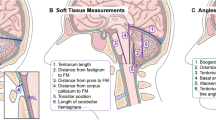Abstract
Introduction
Although very uncommon, Chiari I malformation (CIM) with syringomyelia may be associated with concomitant syringobulbia. We hypothesized that the anatomy of the craniocervical region may be different in CIM patients with syringomyelia who develop syringobulbia in conjunction with their syringomyelia compared to other patients with CIM with and without syringomyelia. The present study was conducted in order to prove or disprove such a theory.
Materials and methods
A group of 189 children with operated CIM were reviewed for the presence of syringobulbia, and this cohort then underwent morphometric analyses of their craniocervical juncture. These measurements were then compared to both our prior patient findings and historic controls.
Results
The current study did not identify any morphometrical peculiarities for patients with CIM and syringobulbia compared to other CIM patients with and without isolated syringomyelia.
Conclusions
Based on our study, the mechanism behind such cerebrospinal fluid distention into the brain stem remains elusive with no single morphometrical difference in patients with CIM and syringobulbia compared to other patients with CIM. Perhaps, future testing aimed at identifying pressure gradients across the foramen magnum in patients with and without syringobulbia and concomitant CIM may be useful.


Similar content being viewed by others
References
Cherman JL, Gitrin CM, Darkovich AJ (1987) MR imaging of syringobulbia, I. Comput Assist Tomogr 11:407–411
Gennaro P, Miller M (1983) Syringobulbia without syringomyelia. Arch Neurol 40:394
Grabb PA, Mapstone TB, Oakes WJ (1999) Ventral brainstem compression in pediatric and young adult patients with Chiari I malformations. Neurosurgery 44:520–528
Greenlee JDW, Menezes AH, Bertoglio BA, Donovan KA (2005) Syringobulbia in a pediatric population. Neurosurgery 57:1147–1153
Kombos T, Ramsbacher J, Brock M (1996) Isolated idiopathic syringobulbia: case report and summary of the literature. Zentralbl Neurochir 57:103–107
Levine DN (2004) The pathogenesis of syringomyelia associated with lesions at the foramen magnum: a critical review of existing theories and proposal of a new hypothesis. J Neurol Sci 220:3–21
Morgan D, Williams B (1992) Syringobulbia: a surgical appraisal. J Neurol Neurosurg Psych 55:1132–1141
Seki T, Hida K, Lee J, Iwasaki Y (2004) Hiccups attributable to syringobulbia and/or syringomyelia associated with a Chiari I malformation: case report. Neurosurgery 54:224–226
Sengar RLS, Prasad VSSV, Prasad BCM, Reddy DR (1994) Giant syringobulbia in childhood. Child’s Nerv Syst 10:350–351
Takahashi Y, Tajima SU, Tokutomi T, Shigemori M (1999) Syringomyelia caused by delayed postoperative tethering of the cervical spinal cord—delayed complication of foramen magnum decompression for Chiari malformation. Acta Neurochir (Wien) 141:969–973
Tubbs RS, Wellons JC III, Blount JP, Grabb PA, Oakes WJ (2003) Inclination of the odontoid process in the pediatric Chiari I malformation. J Neurosurg 98(Supp 1):43–49
Tubbs RS, Webb DB, Oakes WJ (2004) Persistent syringomyelia following pediatric Chiari I decompression: radiological and surgical findings. J Neurosurg 100:460–464
Tubbs RS, Elton S, Grabb P, Dockery SE, Bartolucci AA, Oakes WJ (2001) Analysis of the posterior fossa in children with the Chiari 0 malformation. Neurosurgery 48:1050–1055
Tubbs RS, Iskandar BJ, Bartolucci AA, Oakes WJ (2004) A critical analysis of the Chiari 1.5 malformation. J Neurosurg 101:179–183
Tubbs RS, Wellons JC III, Smyth MD, Bartolucci AA, Blount JP, Oakes WJ, Grabb PA (2003) Children with growth hormone deficiency and Chiari I malformation: a morphometric analysis of the posterior cranial fossa. Pediatr Neurosurg 38:324–328
Tubbs RS, Webb D, Abdullatiff H, Conklin M, Doyle S, Oakes WJ (2004) Posterior cranial fossa volume in patients with rickets: insights into the increased occurrence of Chiari I malformation in metabolic bone disease. Neurosurgery 55:380–384
Tubbs RS, McGirt MJ, Oakes WJ (2003) Surgical experience in 130 pediatric patients with Chiari I malformations. J Neurosurg 99:291–296
Valentini M, Bracchi M, Gaidolfi E, Savoiardo M (1986) Radiologic demonstration of syringobulbia. Report of 8 cases. Acta Radiol 369:245–247
Williams B (1976) Cerebrospinal fluid pressure changes in response to coughing. Brain 99:331–346
Author information
Authors and Affiliations
Corresponding author
Rights and permissions
About this article
Cite this article
Tubbs, R.S., Bailey, M., Barrow, W.C. et al. Morphometric analysis of the craniocervical juncture in children with Chiari I malformation and concomitant syringobulbia. Childs Nerv Syst 25, 689–692 (2009). https://doi.org/10.1007/s00381-009-0810-1
Received:
Published:
Issue Date:
DOI: https://doi.org/10.1007/s00381-009-0810-1




